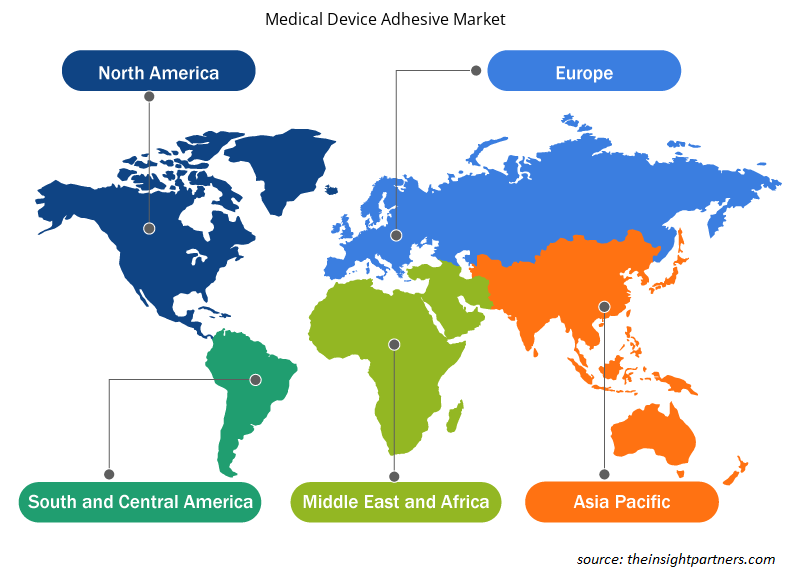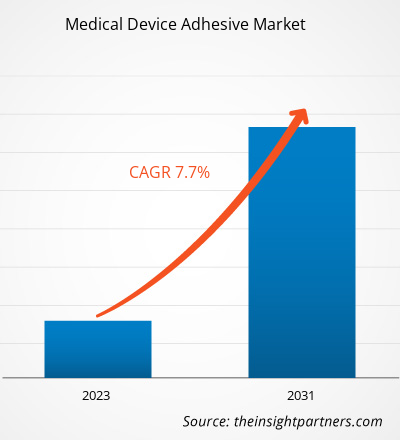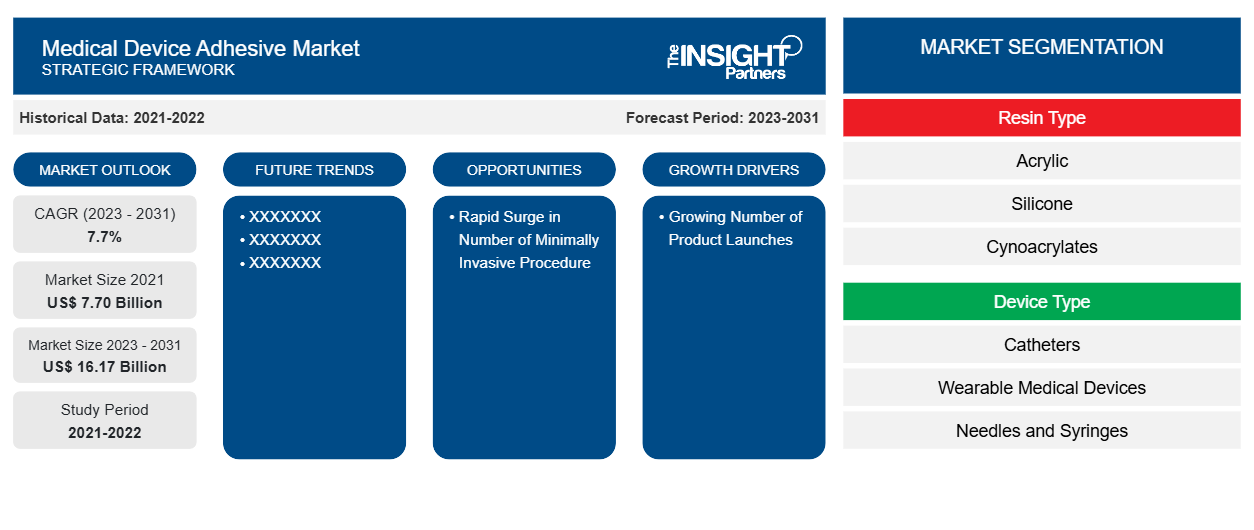La taille du marché des adhésifs pour dispositifs médicaux a été estimée à 7,70 milliards USD en 2021 et à XX millions USD en 2023 et devrait atteindre 16,17 milliards USD d'ici 2031. On estime qu'il enregistrera un TCAC de 7,7 % jusqu'en 2031. L'utilisation croissante d'adhésifs pour dispositifs médicaux, les progrès techniques dans les adhésifs pour dispositifs médicaux et l'adoption croissante de solutions écologiques et biocompatibles resteront probablement les principales tendances du marché des adhésifs pour dispositifs médicaux.
Analyse du marché des adhésifs pour dispositifs médicaux
L'adhésif pour dispositifs médicaux est l'adhésif spécialisé utilisé pour coller des dispositifs ou des composants médicaux, tels que des pansements et des bandages, des cathéters, des fils-guides, des dispositifs médicaux implantables, des matériaux dentaires et bien d'autres. L'adhésif doit répondre à des exigences spécifiques avant d'être sélectionné, telles que la biocompatibilité, la stabilisabilité, la force de liaison élevée et la résistance à l'eau. L'adhésif acrylique est l'un des adhésifs les plus courants qui jouent un rôle crucial dans l'industrie des dispositifs médicaux en raison de ses propriétés garantissant la sécurité et l'efficacité.
Aperçu du marché des adhésifs pour dispositifs médicaux
Les facteurs déterminants comprennent l'utilisation croissante d'adhésifs pour dispositifs médicaux et les avancées technologiques dans ce domaine. Cependant, les complications associées à ces solutions sont susceptibles d'entraver la croissance du marché dans une certaine mesure. Le marché mondial des adhésifs pour dispositifs médicaux est segmenté par région en Amérique du Nord, Europe, Asie-Pacifique, Moyen-Orient et Afrique, et Amérique du Sud et centrale. En Amérique du Nord, les États-Unis détiennent une part importante du marché des adhésifs pour dispositifs médicaux. Les innovations dans la gamme de produits stimulent principalement la croissance du marché du pays. Les pays de la région se concentrent sur le développement de produits à base de technologie de pointe qui contribuent à améliorer la qualité de vie des patients. En outre, le nombre croissant de startups devrait encore stimuler la croissance du marché des adhésifs et des produits d'étanchéité médicaux en Amérique du Nord. La région Asie-Pacifique devrait représenter la croissance la plus rapide du marché des adhésifs pour dispositifs médicaux. Le nombre croissant d'accidents, de procédures de transplantation et le nombre croissant d'entreprises se concentrant sur les pays d'Asie-Pacifique pour leur expansion géographique et d'autres stratégies sont susceptibles d'alimenter la croissance du marché.
Personnalisez ce rapport en fonction de vos besoins
Vous bénéficierez d'une personnalisation gratuite de n'importe quel rapport, y compris de certaines parties de ce rapport, d'une analyse au niveau des pays, d'un pack de données Excel, ainsi que d'offres et de remises exceptionnelles pour les start-ups et les universités.
-
Obtenez les principales tendances clés du marché de ce rapport.Cet échantillon GRATUIT comprendra une analyse de données, allant des tendances du marché aux estimations et prévisions.
Facteurs moteurs et opportunités du marché des adhésifs pour dispositifs médicaux
Nombre croissant de lancements de produits en développement pour favoriser le marché
Les études de recherche et développement en cours dans le monde entier prennent de l'ampleur pour créer des solutions médicales haut de gamme permettant de combiner une large gamme de dispositifs médicaux dans une utilisation pratique. Les entreprises investissent dans le développement d'instruments innovants pour garantir un bon retour sur investissement (ROI). De plus, l'approbation des produits par les autorités réglementaires confirme la fiabilité et la crédibilité des nouveaux adhésifs et produits d'étanchéité pour dispositifs médicaux. Récemment, diverses entreprises du marché ont lancé des adhésifs pour dispositifs médicaux haut de gamme et de qualité supérieure. Par exemple, en novembre 2021, Dymax a lancé une nouvelle gamme d'adhésifs photopolymérisables pour dispositifs médicaux portables . Les nouveaux adhésifs de la série 2000-MW sont exempts de TPO et fabriqués sans IBOA (un irritant cutané connu).ROI). Additionally, product approval by regulatory authorities confirms the reliability and credibility of the new-age medical device sealants and adhesives. Recently, various market companies have launched high-end and top-quality medical device adhesives. For instance, In November 2021, Dymax released a new line of light-curable adhesives for TPO and made without IBOA (a known skin irritant).
Augmentation rapide du nombre de procédures mini-invasives – une opportunitéle marché des adhésifs pour dispositifs médicaux
Les procédures mini-invasives sont les méthodes préférées qui sont adoptées par rapport aux méthodes de chirurgie ouverte traditionnelles, telles que les chirurgies endoscopiques, les procédures de diagnostic endoscopique et les chirurgies assistées par robot. Le processus chirurgical endoscopique est largement suivi pour les opérations liées au cœur, aux poumons, à l'estomac et aux reins. Les plaies post-opératoires sont scellées avec des sutures chirurgicales, des agrafeuses chirurgicales, des produits de scellement ou des rubans adhésifs appropriés. Cependant, en raison des progrès technologiques dans les méthodes de fermeture des plaies, l'adhésif pour dispositifs médicaux fait partie des produits préférés.
Par exemple, une hernie inguinale fait partie des affections les plus courantes observées chez les hommes et les femmes, les interventions chirurgicales étant le seul traitement possible. Les principaux types d'interventions chirurgicales sont la chirurgie ouverte et la laparoscopie. Selon les données du Healthcare Cost and Utilization Project et de la Food and Drug Administration américaine, à l'heure actuelle, 611 000 réparations de hernies ventrales et 1 million de réparations de hernies inguinales ont été réalisées aux États-Unis en 2023. Les opérations de scellement de plaies/coupures pour ces procédures impliquent généralement des produits de scellement médicaux, offrant ainsi une opportunité significative pour les acteurs du marché au cours de la période projetée.
Analyse de segmentation du rapport sur le marché des adhésifs pour dispositifs médicaux
Les segments clés qui ont contribué à l’élaboration de l’analyse du marché des adhésifs pour dispositifs médicaux sont le type de résine et le type de dispositif.
- En fonction du type de résine, le marché des adhésifs pour dispositifs médicaux est divisé en acrylique, silicone, cyanoacrylates, polyuréthane, photopolymérisable et époxy. Le segment acrylique détenait la plus grande part du marché en 2023 ; en outre, le même segment devrait enregistrer le TCAC % le plus élevé du marché au cours de la période de prévision.
- Par type d'appareil, le marché est segmenté en cathéters, dispositifs médicaux portables, aiguilles et seringues, stimulateurs cardiaques, ensembles de tubes et masques. Le segment des cathéters détenait la plus grande part du marché en 2023 ; tandis que les appareils portables devraient enregistrer le TCAC le plus élevé du marché au cours de la période 2023-2031.
Analyse des parts de marché des adhésifs pour dispositifs médicaux par zone géographique
Français La portée géographique du rapport sur le marché des adhésifs pour dispositifs médicaux est principalement divisée en cinq régions : Amérique du Nord, Asie-Pacifique, Europe, Moyen-Orient et Afrique, et Amérique du Sud/Amérique du Sud et centrale. L'Amérique du Nord domine le marché des adhésifs pour dispositifs médicaux, suivie de l'Europe. La croissance de ce marché est principalement tirée par les acteurs du marché qui détiennent la plus grande part de marché dans l'industrie de la fabrication d'adhésifs et de produits d'étanchéité médicaux, tels que Dymax Corporation, 3M Company, Johnson & Johnson et Baxter International Inc. Par exemple, Dymax Corporation lance Dymax MD® 1040-M, un adhésif résistant à l'autoclave pour les instruments médicaux et l'assemblage. L'adhésif est lancé dans le cadre de sa gamme d'adhésifs MD®. L'Asie-Pacifique est le marché des adhésifs pour dispositifs médicaux qui connaît la croissance la plus rapide au monde. La Chine, l'Inde et le Japon sont les trois principaux contributeurs à la croissance du marché, tirée par l'augmentation des dépenses de santé par habitant dans les pays.
Aperçu régional du marché des adhésifs pour dispositifs médicaux
Les tendances et facteurs régionaux influençant le marché des adhésifs pour dispositifs médicaux tout au long de la période de prévision ont été expliqués en détail par les analystes d’Insight Partners. Cette section traite également des segments et de la géographie du marché des adhésifs pour dispositifs médicaux en Amérique du Nord, en Europe, en Asie-Pacifique, au Moyen-Orient et en Afrique, ainsi qu’en Amérique du Sud et en Amérique centrale.

- Obtenez les données régionales spécifiques au marché des adhésifs pour dispositifs médicaux
Portée du rapport sur le marché des adhésifs pour dispositifs médicaux
| Attribut de rapport | Détails |
|---|---|
| Taille du marché en 2021 | 7,70 milliards de dollars américains |
| Taille du marché d'ici 2031 | 16,17 milliards de dollars américains |
| Taux de croissance annuel composé mondial (2023-2031) | 7,7% |
| Données historiques | 2021-2022 |
| Période de prévision | 2023-2031 |
| Segments couverts |
Par type de résine
|
| Régions et pays couverts |
Amérique du Nord
|
| Leaders du marché et profils d'entreprises clés |
|
Densité des acteurs du marché des adhésifs pour dispositifs médicaux : comprendre son impact sur la dynamique commerciale
Le marché des adhésifs pour dispositifs médicaux connaît une croissance rapide, tirée par la demande croissante des utilisateurs finaux en raison de facteurs tels que l'évolution des préférences des consommateurs, les avancées technologiques et une plus grande sensibilisation aux avantages du produit. À mesure que la demande augmente, les entreprises élargissent leurs offres, innovent pour répondre aux besoins des consommateurs et capitalisent sur les tendances émergentes, ce qui alimente davantage la croissance du marché.
La densité des acteurs du marché fait référence à la répartition des entreprises ou des sociétés opérant sur un marché ou un secteur particulier. Elle indique le nombre de concurrents (acteurs du marché) présents sur un marché donné par rapport à sa taille ou à sa valeur marchande totale.
Les principales entreprises opérant sur le marché des adhésifs pour dispositifs médicaux sont :
- GlaxoSmithKline plc.
- AstraZeneca
- Pfizer Inc
- BD
- Sanofi
- Merck & Co., Inc.
Avis de non-responsabilité : les sociétés répertoriées ci-dessus ne sont pas classées dans un ordre particulier.

- Obtenez un aperçu des principaux acteurs du marché des adhésifs pour dispositifs médicaux
Actualités et développements récents du marché des adhésifs pour dispositifs médicaux
Le marché des adhésifs pour dispositifs médicaux est évalué en collectant des données qualitatives et quantitatives après des recherches primaires et secondaires, qui comprennent d'importantes publications d'entreprise, des données d'association et des bases de données. Voici une liste des développements sur le marché des adhésifs et des stratégies pour dispositifs médicaux :
- En juin 2023, Dymax, l'un des principaux fabricants de matériaux et d'équipements à durcissement rapide, est heureux d'annoncer la sortie du HLC-M-1000, le premier produit de sa nouvelle série d'adhésifs photopolymérisables hybrides (HLC). (Source : Dymax, communiqué de presse, 2023)
- En avril 2023, Dymax a lancé l'adhésif 1045-M pour les dispositifs d'administration de médicaments. Dymax a conçu le MD 1045-M pour coller des substrats en verre, SS, ABS et PC. Les utilisations de ces derniers comprennent l'assemblage de seringues préremplies et de dispositifs à usage unique. Ils aident également à l'assemblage d'injecteurs automatiques, de stylos et portables. La société a formulé le MD 1045-M pour résoudre les problèmes liés à l'orientation de l'aiguille, au débordement de matériau et aux longs temps de durcissement. Source : (Prelude Fertility, communiqué de presse, 2024)
Rapport sur le marché des adhésifs pour dispositifs médicaux : couverture et livrables
Le rapport « Taille et prévisions du marché des adhésifs pour dispositifs médicaux (2021-2031) » fournit une analyse détaillée du marché couvrant les domaines ci-dessous :
- Taille du marché et prévisions aux niveaux mondial, régional et national pour tous les segments de marché clés couverts par le périmètre.
- Dynamique du marché, comme les facteurs moteurs, les contraintes et les opportunités clés
- Principales tendances futures
- Analyse détaillée des cinq forces de PEST/Porter et SWOT
- Analyse du marché mondial et régional couvrant les principales tendances du marché, les principaux acteurs, les réglementations et les développements récents du marché.
- Analyse du paysage industriel et de la concurrence couvrant la concentration du marché, l'analyse de la carte thermique, les principaux acteurs et les développements récents.
- Profils d'entreprise détaillés
- Analyse historique (2 ans), année de base, prévision (7 ans) avec TCAC
- Analyse PEST et SWOT
- Taille du marché Valeur / Volume - Mondial, Régional, Pays
- Industrie et paysage concurrentiel
- Ensemble de données Excel
Rapports récents
Rapports connexes
Témoignages
Raison d'acheter
- Prise de décision éclairée
- Compréhension de la dynamique du marché
- Analyse concurrentielle
- Connaissances clients
- Prévisions de marché
- Atténuation des risques
- Planification stratégique
- Justification des investissements
- Identification des marchés émergents
- Amélioration des stratégies marketing
- Amélioration de l'efficacité opérationnelle
- Alignement sur les tendances réglementaires























 Obtenez un échantillon gratuit pour - Marché des adhésifs pour dispositifs médicaux
Obtenez un échantillon gratuit pour - Marché des adhésifs pour dispositifs médicaux